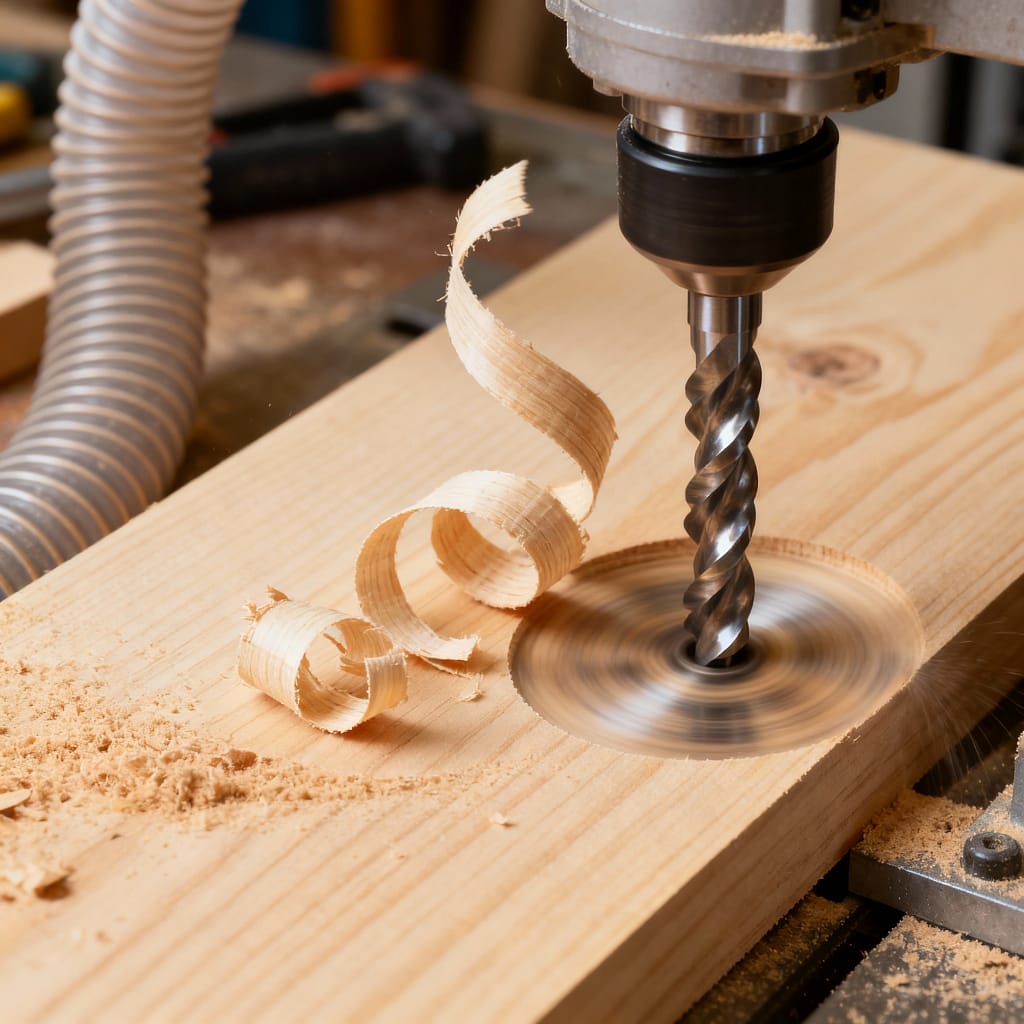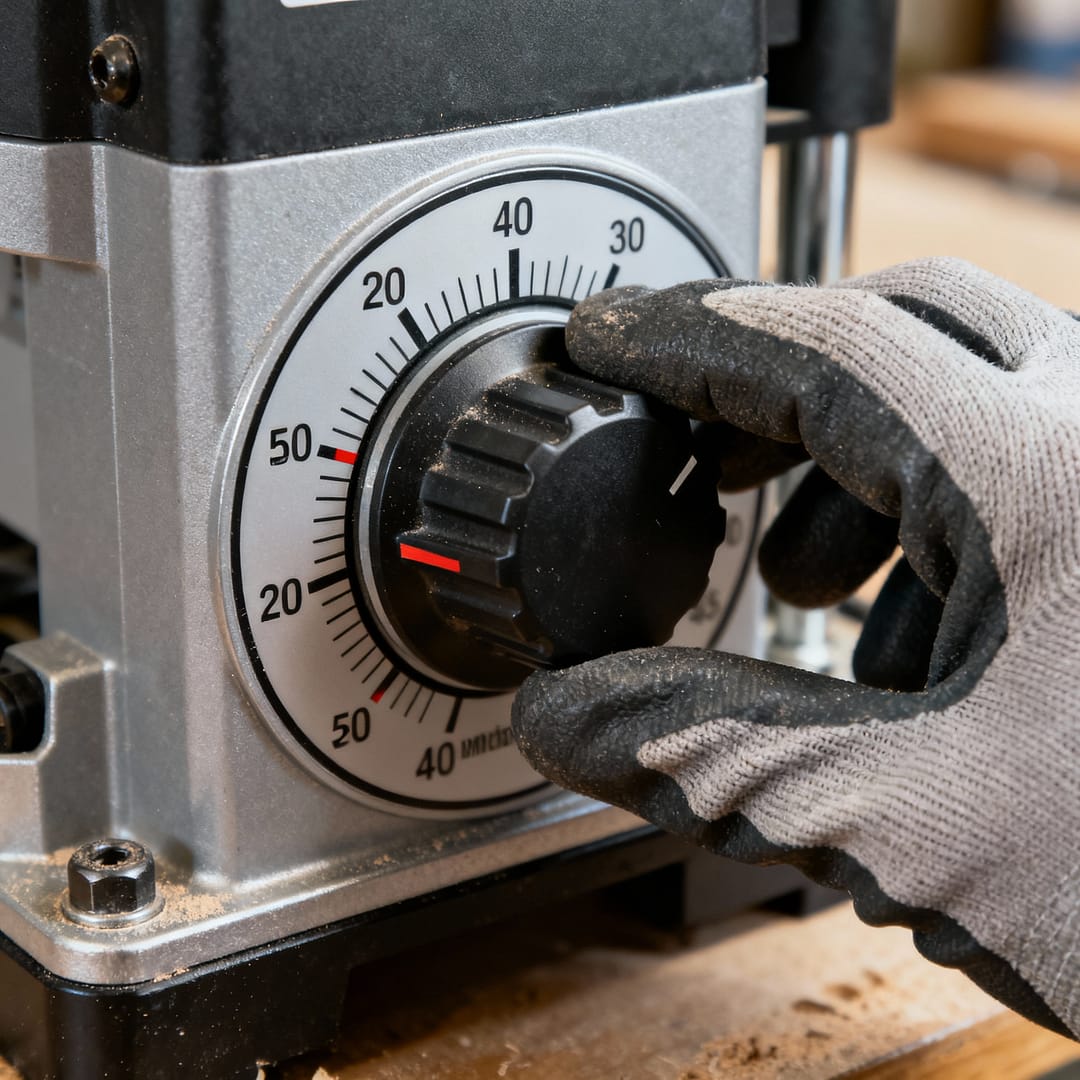Master Router Bit Speeds: The Complete RPM Guide Every Woodworker Needs

I still cringe when I think about my first serious router purchase. I was so excited to start making those beautiful decorative edges I’d seen in magazines. I set the speed to “max,” clamped down a piece of cherry, and fired it up.
Smoke.
Splintered edges.
And worst of all—that horrifying screeching sound that told me I’d just destroyed a $45 dovetail bit.
That day cost me $78 in ruined materials and bits, plus a serious blow to my confidence.
Turns out, router bit speeds aren’t just a suggestion—they’re the difference between professional results and workshop disasters. And no, “just run it fast” isn’t the answer.
Here’s the hard truth I learned the expensive way: Your router’s speed dial exists for a reason. Get it wrong, and you’ll burn wood, break expensive bits, and potentially create dangerous kickback situations. Get it right, and you’ll achieve glass-smooth cuts that make people ask, “Did you really make that yourself?”
If you’re tired of guessing at router bit speeds, tired of replacing broken carbide tips, or tired of sanding away burn marks instead of finishing your projects—this guide is your new best friend.
Let’s decode router bit speeds once and for all.
Why Router Speed Matters More Than You Think
Most beginners focus entirely on which bit to use, completely ignoring the critical factor that determines whether that bit will work properly: speed.
Router bits aren’t created equal. Unlike drill bits that typically spin at one speed, router bits have specific speed requirements based on:
- Bit diameter (larger bits need slower speeds)
- Cutting edge design (more complex profiles need careful speed control)
- Material being cut (hardwoods vs. softwoods vs. composites)
- Cut depth (deeper cuts require slower feeds and adjusted speeds)
When you ignore these factors, physics takes over:
Centrifugal force increases exponentially with speed. A 1-1/2″ bit spinning at 24,000 RPM experiences forces that can literally tear the carbide tips off the bit body. I’ve seen bits shatter mid-cut—scary stuff that can destroy your workpiece and potentially injure you.
Heat builds up when the bit dwells too long in the cut. Too slow on hardwoods creates friction burns. Too fast creates heat from air resistance and vibration. Both ruin your project.
Vibration magnifies at certain resonant frequencies. Every bit has a “danger zone” where vibration becomes destructive. Professional shops spend thousands on vibration analysis equipment—I’m giving you the simplified version that works for home workshops.
Understanding router bit speeds isn’t just technical—it’s fundamental to your safety and success.

The Complete Router Bit Speeds Guide (By Bit Type)
Let’s break down exactly what speed settings you should use for each common bit type. Save this section—you’ll reference it constantly.
Straight Bits: The Foundation of Every Shop
Straight bits are your workhorses. From dados to mortises, they’re used constantly—but they’re also most prone to speed-related failures.
Small diameter (1/4″ or less):
- Softwoods: 22,000-24,000 RPM
- Hardwoods: 18,000-20,000 RPM
- Plywood/MDF: 20,000-22,000 RPM
Medium diameter (3/8″ to 1/2″):
- Softwoods: 18,000-20,000 RPM
- Hardwoods: 15,000-18,000 RPM
- Plywood/MDF: 16,000-18,000 RPM
Large diameter (5/8″ and up):
- Softwoods: 14,000-16,000 RPM
- Hardwoods: 12,000-14,000 RPM
- Plywood/MDF: 14,000-16,000 RPM
💡 Daniel’s Hard-Won Lesson: I ruined three 3/4″ straight bits in one afternoon trying to clean out mortises in oak at full speed. My shop sounded like a popcorn machine as carbide tips flew off. The fix? Slowing down to 12,000 RPM and making multiple shallow passes. Now my mortises are cleaner than ever.
Round-Over Bits: Creating That Perfect Edge
Round-over bits create beautiful edges on tabletops, shelves, and drawer fronts. They’re deceptively tricky to run at proper router bit speeds.
1/8″ to 1/4″ radius:
- All woods: 18,000-22,000 RPM
- Exception: Large hardwood panels at 16,000 RPM
3/8″ to 1/2″ radius:
- Softwoods: 16,000-18,000 RPM
- Hardwoods: 14,000-16,000 RPM
5/8″ and larger radius:
- All woods: 10,000-14,000 RPM
- Critical: Never exceed 14,000 RPM regardless of wood type
The larger the radius, the more surface area the bit contacts simultaneously. This creates tremendous heat and stress at high speeds. I always run large round-over bits at 12,000 RPM on my heavy-duty router—it’s slower but absolutely eliminates burning on maple and cherry.
Dovetail Bits: Precision Joinery Demands Precision Speeds
Dovetail joints are beautiful but unforgiving. Your router bit speeds must be spot-on to get clean, tight-fitting pins and tails.
Standard dovetail bits (7°-14°):
- Softwoods: 16,000-18,000 RPM
- Hardwoods: 12,000-14,000 RPM
- Baltic birch plywood: 14,000-16,000 RPM
Half-blind dovetail bits:
- All materials: 14,000-16,000 RPM
The secret pro tip? Run dovetail bits slightly slower than you think necessary. Clean, precise cuts matter more than speed here. I’d rather take an extra minute on proper router bit speeds than spend an hour fixing poorly cut joints.
V-Groove Bits: Decorative Work Requires Special Attention
V-groove bits create beautiful decorative lines and inlays, but their sharp points are vulnerable to breaking at improper speeds.
Small V-bits (1/8″ to 1/4″ width):
- Softwoods: 20,000-22,000 RPM
- Hardwoods: 16,000-18,000 RPM
Medium V-bits (3/8″ width):
- Softwoods: 16,000-18,000 RPM
- Hardwoods: 14,000-16,000 RPM
Large V-bits (1/2″ and wider):
- All materials: 12,000-14,000 RPM
V-bits have a critical weakness: their center point. At excessive speeds, this point can snap off, ruining both your bit and your project. I always run V-bits 10% slower than my standard setting for their diameter—better safe than sorry.
Flush Trim Bits: Template Work Demands Consistent Speeds
Flush trim bits with their ball bearings are workhorses for template routing, but speed control is critical for bearing longevity.
Small diameter (1/2″):
- All materials: 18,000-20,000 RPM
Medium diameter (3/4″):
- Softwoods: 16,000-18,000 RPM
- Hardwoods: 14,000-16,000 RPM
Large diameter (1″ and up):
- All materials: 12,000-14,000 RPM
Pro tip: When using flush trim bits in a router table versus handheld, I reduce the speed by about 10% for table work. The workpiece feeds more consistently against the bit, requiring less aggressive speed.
Special Cases: Router Bit Speeds for Tricky Materials
Some materials require special router bit speeds regardless of bit type:
Plywood and MDF:
- 16,000-18,000 RPM for bits under 1/2″
- 14,000-16,000 RPM for larger bits
Pressure-treated lumber:
- Always reduce speeds by 20% (the chemicals cause faster bit wear)
Exotic hardwoods (purpleheart, cocobolo, etc.):
- 12,000-14,000 RPM regardless of bit size (their extreme density generates heat rapidly)
The Router Speed Reference Chart (Bookmark This!)
Bit Diameter | Softwoods | Hardwoods | Plywood/MDF | Large Bits (1″+) |
|---|---|---|---|---|
1/4″ or less | 22-24K RPM | 18-20K RPM | 20-22K RPM | N/A |
3/8″-1/2″ | 18-20K RPM | 15-18K RPM | 16-18K RPM | 14-16K RPM |
5/8″-3/4″ | 16-18K RPM | 14-16K RPM | 14-16K RPM | 12-14K RPM |
1″+ | 14-16K RPM | 12-14K RPM | 14-16K RPM | 10-12K RPM |
Print this chart, laminate it, and hang it in your shop. I keep a copy taped to my router table fence—best $0.23 investment I ever made.
Common Router Speed Mistakes (And How to Fix Them)
After teaching hundreds of students proper router bit speeds, I’ve seen the same mistakes repeatedly. Avoid these pitfalls:
Mistake #1: “Full Speed for Everything”
That speed dial has numbers for a reason. Yes, it’s convenient to leave it at max, but you’re sacrificing quality and safety.
Fix: Create speed presets for your most-used bits. Mark them with colored tape on your router’s speed dial.
Mistake #2: Ignoring Bit Diameter Rules
I once watched a student try to run a 2″ panel raising bit at 24,000 RPM. The resulting vibration shook tools off his shelves.
Fix: Remember this rule: For every 1/4″ increase in diameter beyond 1/2″, reduce speed by 2,000 RPM.
Mistake #3: Forgetting Environmental Factors
Humidity, temperature, and even altitude affect optimal router bit speeds. In my high-desert shop, I run 10% slower in winter when the wood is drier and more brittle.
Fix: Keep a workshop journal noting speed adjustments for seasonal changes. After a few years, you’ll have your own personalized reference guide.
Mistake #4: Not Matching Feed Rate to Speed
Speed and feed rate work together. Slow speed requires slower feed; fast speed allows faster feed.
Fix: Use this test: When making a cut, look at the shavings. Long, continuous curls = perfect. Dust or powder = too slow. Burning or chipping = too fast.
Advanced Router Speed Techniques for Perfect Results
Once you’ve mastered the basics of router bit speeds, these pro techniques will elevate your work:
The Variable Speed Dance
For complex profiles with both straight and curved sections, don’t be afraid to adjust speed mid-project. I’ll often start at a higher RPM for the straight sections, then reduce speed 10-15% when approaching tight curves where the bit experiences more stress.
Climb Cutting with Speed Control
For difficult grain patterns that cause tear-out, I sometimes use a light climb cut (feeding with the rotation) at 15% reduced speed. This technique requires practice and extreme caution—always use featherboards and push blocks.
Multi-Pass Strategy with Speed Adjustments
For deep cuts (over 1/4″), I use a three-pass approach:
- First pass: 20% higher than standard speed (removes bulk material)
- Second pass: Standard speed (cleans up walls)
- Final pass: 15% below standard speed (perfect finish)
This technique is especially valuable for router table work where precision matters .
Troubleshooting Router Bit Problems Through Speed Adjustment
Not sure if your router issues are speed-related? Here’s my diagnostic guide:
Symptom: Black burn marks on wood
→ Likely cause: Speed too low for feed rate
→ Fix: Increase speed OR maintain speed but feed faster
Symptom: Rough, fuzzy cuts
→ Likely cause: Speed too high for bit diameter
→ Fix: Reduce speed by 20% and test again
Symptom: Violent vibration or chattering
→ Likely cause: Hitting resonant frequency
→ Fix: Adjust speed 10% higher OR lower to find the “quiet zone”
Symptom: Torn-out edges on end grain
→ Likely cause: Speed too low for hardwood
→ Fix: Increase speed and use backing board technique
These troubleshooting tips saved my sanity during a complex wood joinery project last winter . Understanding router bit speeds transformed frustrating failures into beautiful, tight-fitting joints.
Your Router Speed Action Plan
Here’s exactly what to do today to master router bit speeds:
- Create your speed reference chart using the table above. Laminate it.
- Mark your router’s speed dial with colored tape for your most-used bits.
- Practice on scrap wood this weekend—test how different speeds affect cut quality on your common materials.
- Check your router’s manual for maximum safe speeds for large-diameter bits.
- Invest in a digital tachometer ($25 on Amazon) to verify your router’s actual speeds versus the dial settings. Many older routers run faster or slower than indicated.
Remember my $78 lesson? I now spend 30 seconds checking my speed dial before every routing operation. That small habit has saved me hundreds in ruined bits and materials.
Ready to Master Your Router Like a Pro?
Perfect router bit speeds are just one piece of the precision woodworking puzzle. When combined with proper technique, sharp bits, and a well-tuned workshop, they transform your projects from “homemade” to “handcrafted.”
At HMZ Woodz, I’ve spent 15 years refining the systems that separate frustrating woodworking from the kind that makes you lose track of time. The complete system—including router techniques, table saw mastery, and workshop efficiency—is exactly what I poured into The Table Saw Master’s Playbook.
This isn’t just another woodworking eBook. It’s the complete precision system that’s helped over 3,200 woodworkers build with confidence. Inside, you’ll find:
- The “5-Cut Method” for perfect table saw alignment
- 12 essential jigs (with full plans) that solve 90% of common problems
- Router techniques that work on any budget
- Workshop layout secrets for small spaces
- And the complete speed reference system (expanded from this guide)
Get the complete system in The Table Saw Master’s Playbook — $37
As a Woodz Insider, you’ll also receive my FREE Router Speed Reference Card—a laminated, pocket-sized version of the speed chart in this article that fits perfectly in your router case.
Download Your Free Router Speed Reference Card
Because you didn’t get into woodworking to fight your tools. You got into it to create something meaningful. And that journey starts with understanding the fundamentals—like router bit speeds—that make everything else possible.
